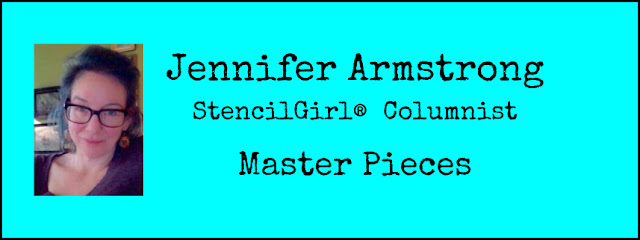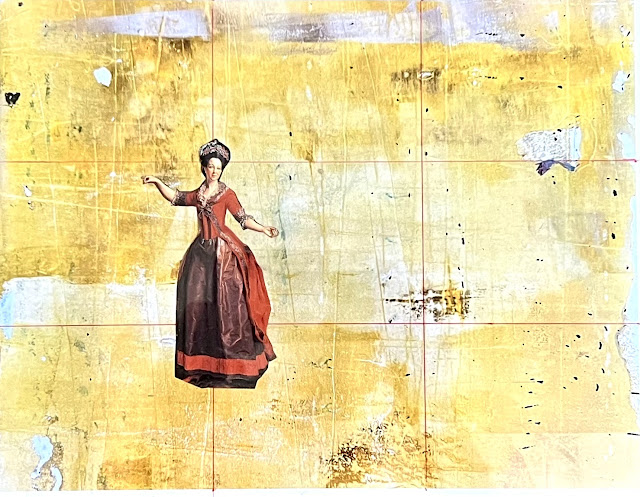 |
| The Sleigh Ride, Winslow Homer |
Visiting Winslow Homer
Welcome to my second Master Pieces column, where I study a masterwork to glean something useful that I can use in my own work. Like many of you, I am a mixed media artist, and lately I have been working a lot in collage. Specifically, my recent collage work has used images cut from art history books, and that's where I'll be going with my project today. But first, let us turn our attention to American painter, Winslow Homer. I live within driving distance of the Clark Art Institute in Williamstown, Massachusetts, which houses some lovely works by Homer. One of them, The Sleigh Ride (c. 1890), has been my first stop on every visit - I go at least a couple of times every year. To me this is a mysterious and evocative image, the sleigh just about to disappear over the crest of the hill on a dark, cold night. I adore it. For a long time, I was content to just look at it and appreciate it each time I visited. But eventually I decided to figure out how this painting works, hoping to learn something about why it exerts such a strong pull on me. Here's a page from one of my sketchbooks, dated 2018, showing a study I did of it - and what I want to talk about in this column is the compositional structure. As you can see, I drew diagonals on a printout, and then from the corners, drew lines that are
 perpendicular to the diagonals. As you can see, the painting adheres to these lines pretty rigorously. This compositional structure is called dynamic symmetry, and it is the compositional structure that you will see in painting after painting when you start looking - trust me, if you start paging through a book of old master paintings with a ruler and a right angle tool in your hand, you will begin to see how frequently this device is used.
perpendicular to the diagonals. As you can see, the painting adheres to these lines pretty rigorously. This compositional structure is called dynamic symmetry, and it is the compositional structure that you will see in painting after painting when you start looking - trust me, if you start paging through a book of old master paintings with a ruler and a right angle tool in your hand, you will begin to see how frequently this device is used.
So - let's look at some more Winslow Homer paintings to see if he used this structure in other works.
 |
| Winslow Homer, Undertow, c. 1886, Clark Art Institute |
 |
| Winslow Homer, Girl Carrying a Basket, c. 1882, National Gallery of Art |
 |
| Winslow Homer, Long Branch, New Jersey, c. 1869, Museum of Fine Arts, Boston |
Clearly this is a framework that Homer was very accustomed to using - paintings spanning at least 1869 to 1890 use this device; 21 years is a long time in a painter's career. It's a bit astonishing how the major compositional elements align with the dynamic symmetry lines - the alignment of the figures in Undertow is especially striking. What's instructive to notice here is that the acute triangle created by these lines, typically in the upper half of the painting, is where the focal point of the painting is. I have to conclude that our brains find this spot intriguing and satisfying, our subconscious minds happily drawing in all kinds of lines to establish patterns. With the lines drawn over the paintings it's clear how the composition is assembled, but take the lines away and you might not realize the structure at first glance - but your brain will. And your brain will like it.
Composition is one of the "art things" that gives many people a hard time, but one technique that most people are familiar with is the "Rule of Thirds." It's a quick and reliable way to compose a drawing, painting, or photograph (my phone has Rule of Thirds grid lines in the camera viewfinder), and by using the intersections as "hot spots," you can establish a workable composition. But... if you use dynamic symmetry your composition becomes - dynamic! Let's try it.
 |
| Here's a lady I want to collage. Sorry, original artist, I don't remember who you are. Where on the background should I put her? She's just floating right now. |
 |
| If I use the Rule of Thirds, I can position her in one of the hot spots - but where, exactly? Is this a good spot, aligned vertically with that grid line? But how far up or down that line is best? |
If this layout is good enough for Winslow Homer, it's good enough for me. But let's add some additional elements and see what it looks like. I have some botanical collage elements to try. Let's try a layout using the Rule of Thirds.
 |
| It's okay. The branch is on one horizontal and she is on a vertical. It seems...fine. |
So I'm going with this composition. Time to get some stenciling in here, isn't it? I need to beef up the botanical element, so I'm going to use a favorite stencil, Dancing Lights, by Daniella Woolf (S355) and one by Rae Missigman from her Mix and Match Botanicals club set of December, 2021.
So happy autumn, everyone! Please give dynamic symmetry a try the next time you are struggling with composition. It's fun to experiment, and it's always nice to know that Winslow Homer would say "I see what you did there."
Stencils used:
 |
| Dancing Lights, Daniella Woolf S355 |
 |
| Rae Missigman, December 2021 |





Wow! So interesting, thanks so much!
ReplyDeleteFascinating and inspiring column - thanks so much, Jennifer!
ReplyDeleteWhat a great blog article! Thank you!
ReplyDeleteMost useful. Thank you
ReplyDeleteFascinating and wonderfully explained! Thank you.
ReplyDelete